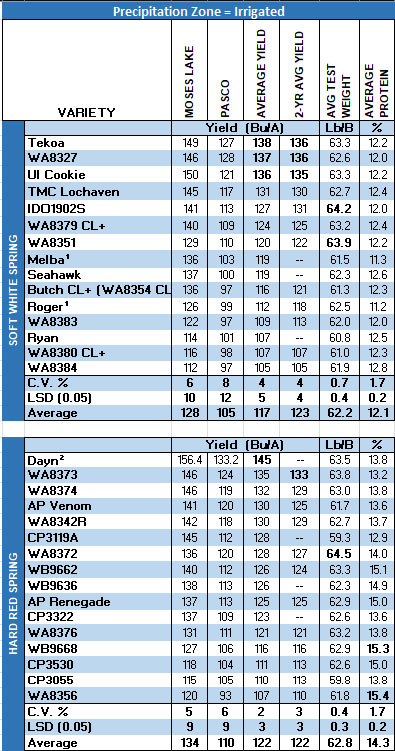Results show bright future for new wheat lines
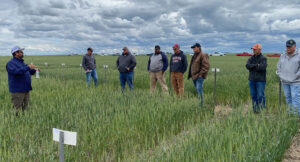
The 2023 season was a bit of a mixed bag this past year in terms of spring wheat performance. While the vast majority of trials were down 20% to 30% on average for yield compared to the 2022 season, there were a few bright spots, including yields that were 59% higher at Almira and 36% greater at Fairfield. Planted acreage for spring wheat in Washington in 2023 was up about 5% over 2022 to around 500,000 acres according to the National Agricultural Statistics Service. Roughly 74% of those acres went to soft white spring, while the remainder went to the hard red spring class.
One of the newer hard red spring wheat releases from WestBred, WB9623, may be in the hunt for some of these acres. It has consistently yielded above the trial average in all zones with close-to-average test weight in the trials. While it certainly has a yield advantage over WB9668 and WB9303, do not expect the same high levels of grain protein seen in those varieties. Like with test weight, grain protein levels for WB9623 are typically close to the trial average, similar to other high yielding varieties like Hale. While WB9623 has a solid agronomic package for Hessian fly and aluminum tolerance, recent stripe rust screenings rank it as moderately susceptible.
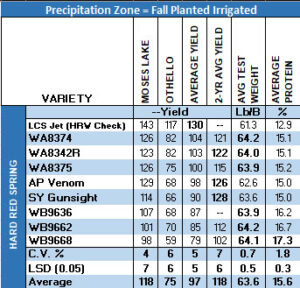
After an initial delay in seed production, certified seed of Hale should be widely available for growers interested in hard red spring wheats in 2024. This relatively new variety, released by Washington State University (WSU) in 2022, maintains the best two- and three-year yield average in all but the lowest precipitation zone. Growers will notice that Croplan submitted a number of new varieties that were consistently at the top of the trial in 2023, including CP3055, CP3119A, CP3322, and CP3530. While some of these lines beat out Hale and other high yielding varieties in many cases, growers should pay close attention to test weights on these lines as they regularly came in below 60 pounds per bushel. CP3322 was the best of the group and might be considered acceptable test weight, though it was still routinely below the trial average. CP3322 did receive a moderately resistant score for stripe rust.
Under irrigation, AP Venom continues to lead the released hard red spring varieties for yield, but has competition from some advanced breeding lines, specifically WA8373 and WA8342R, which are outyielding it by four to eight bushels on the multiyear averages. These lines have similar protein and straw strength as AP Venom, but have better test weight. On 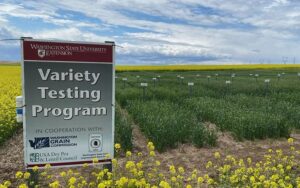 the soft white spring side, Tekoa and UI Cookie continue to lead the released soft white spring varieties for yield under irrigation. While experimental line WA8327 has shown similar high yield potential as these two varieties, straw strength does not appear to be quite as good.
the soft white spring side, Tekoa and UI Cookie continue to lead the released soft white spring varieties for yield under irrigation. While experimental line WA8327 has shown similar high yield potential as these two varieties, straw strength does not appear to be quite as good.
For fall planted hard red spring wheat, AP Venom and SY Gunsight continued neck and neck for the top yield on the three-year average. While SY Gunsight has a slight advantage on test weight, AP Venom maintains a slight advantage on grain protein. The 2023 Moses Lake trial offered a unique opportunity to rate emergence this past year on the fall-planted spring wheats due to delayed emergence from the early cold snap experienced in fall of 2022. Of these two varieties, AP Venom clearly had the advantage over SY Gunsight for emergence. WB9636 and WB9662 received some of the best emergence ratings, while WB9668 received one of the lowest ratings in the trials, similar to SY Gunsight.
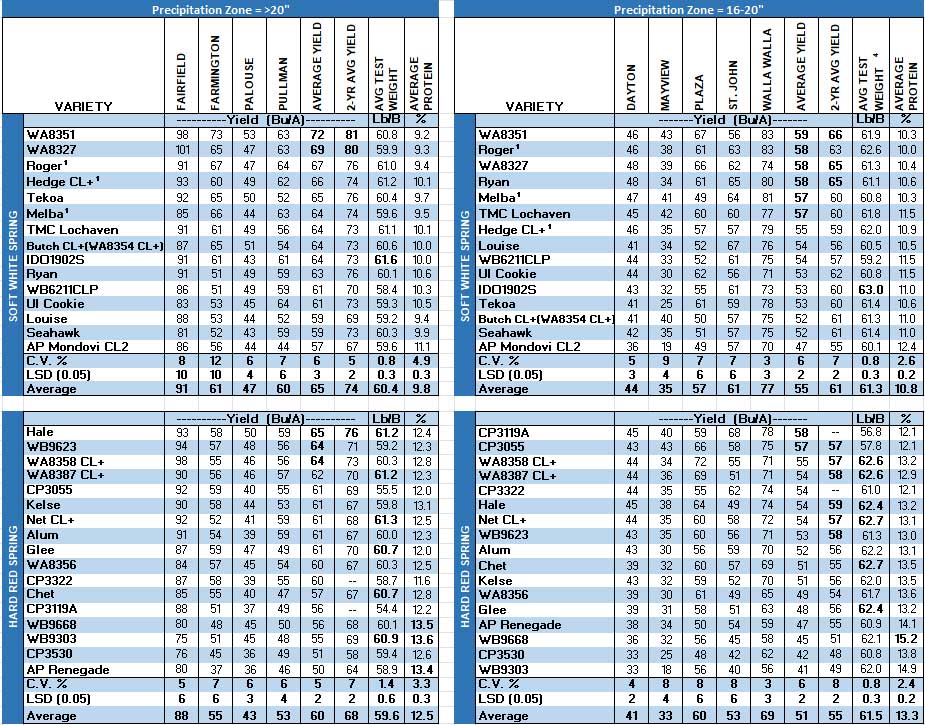
When looking at the soft white spring wheat results, some varieties that traditionally are high yielders struggled somewhat in 2023, including Ryan, in some cases, and especially Seahawk. The biggest takeaway for me, however, was looking at what is coming down the pipeline for future releases.
If you spent any time looking at the 2023 variety testing summary tables, you might have noticed that WA8351 was leading the pack both on the 2023 and the two-year yield averages in nearly every instance, and in many cases, it was even statistically superior to all released commercial varieties. In addition to exceptional yield potential, test weight for WA8351 was also above the trial average in every zone and consistently produced 1 to 1.5 pounds per bushel more compared to Ryan. Furthermore, threshing ability is superior to Ryan, which is
one of the few complaints growers have with that variety. With strong resistance to stripe rust, Hessian fly, and moderately good aluminum tolerance, it is safe to say WA8351 has a solid agronomic package to back up its yield and test weight potential. This line comes from a cross with Tekoa and also has Louise and Alpowa in its pedigree. While final approval is still needed, foundation seed will be available in 2024 and expect an official name to be announced this coming spring.
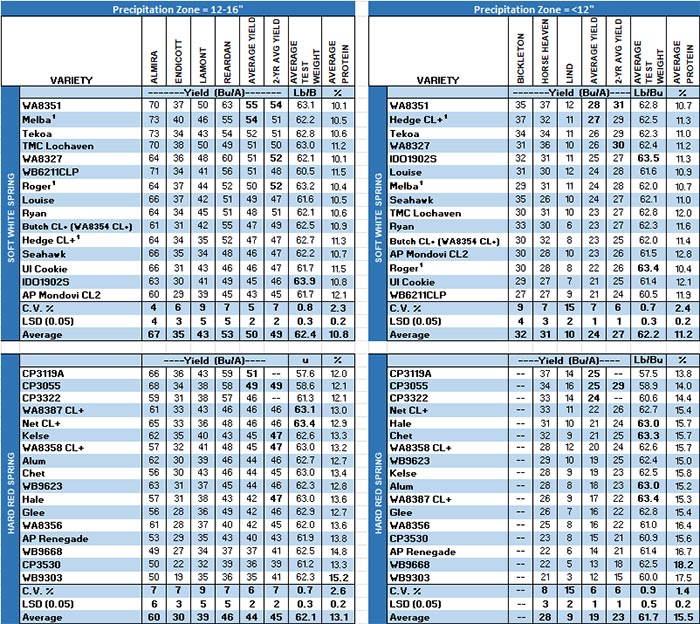
As exciting as WA8351 is, Butch CL+ (WA8354 CL+) is also likely to grab some acres in the coming year. Released in 2023, Butch CL+ is the first two-gene Clearfield soft white spring
wheat released by WSU. While it struggled a little in 2023 compared to previous years, it still maintains a three-to-six-bushel-per-acre yield advantage over WB6211CLP and AP Mondovi CL2 in the higher precipitation zones, with comparable yields in lower precipitation zones. It generally has a one-to-two-pound per bushel test weight advantage and lower protein than the other Clearfield varieties as well.
The newest spring club wheat, Roger, continues to outyield Melba in the high precipitation zones with better test weight and lower protein. Its Hessian fly resistance is also sure to help it pick up acres from Melba in the coming years.
Tables 1-3 show a quick summary of variety performance in 2023; however, growers are encouraged to visit our website at smallgrains.wsu.edu/variety if they want to view additional information on long term yield averages, plant height, heading dates, and a multitude of other agronomic and disease resistance ratings. The Variety Testing Program would like to thank the Washington Grain Commission for the funding to conduct these trials as well as all of our grower cooperators that host the trials on their farms. Furthermore, we would like to acknowledge the many research programs involved in the generation of the many variety ratings developed each year to provide the most information possible to growers to help them make the best informed decisions for their operations. If you have questions or concerns, feel free to contact me at clark.neely@wsu.edu.
This article originally appeared in the January 2024 issue of Wheat Life Magazine.

Clark Neely, Ph.D.
Clark Neely is the cereal variety testing lead and extension agronomist at Washington State University. His research interests include dryland cropping systems and advancing cereal variety testing. Read more about Dr. Neely.

